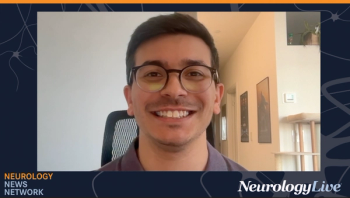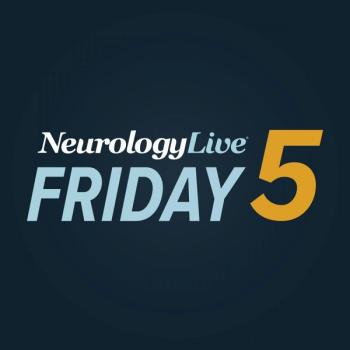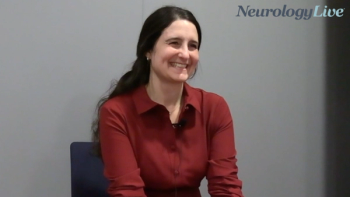
Elena Grebenciucova, MD, on Evolving Standards in NMOSD Diagnosis and Management

The assistant professor of neurology at Northwestern University explained key diagnostic, therapeutic, and management considerations for clinicians caring for patients with NMOSD across diverse and evolving clinical scenarios.
Neuromyelitis optica spectrum disorder (NMOSD) remains one of the most challenging neuroimmunologic diseases for clinicians, given its potential for severe relapses, its overlapping presentation with conditions such as MOGAD and MS, and the critical need for rapid, accurate diagnosis. With ongoing changes to its diagnostic criteria and an expanding understanding of seropositive and seronegative phenotypes, the field continues to evolve in real time. Updated guidance presented at recent international meetings, including the 2025 revisions to NMOSD criteria, highlights important distinctions in disease biology, testing reliability, and therapeutic responsiveness, underscoring why clinical vigilance and high-quality antibody testing are essential components of care.
In this conversation,
NeurologyLive®: For young clinicians entering neuroimmunology, what aspects of NMOSD are most critical to effectively treating the disease?
Elena Grebenciucova, MD: First and foremost is clinical syndrome recognition. Recognizing optic neuritis, particularly when it is severe or bilateral, should prompt testing for aquaporin-4 antibody and for MOG antibody. It is also important to remember that optic neuritis can be mild, and mild cases should not preclude antibody testing. Another key point is the specimen used for testing. The standard of care for both aquaporin-4 and MOG antibody testing is serum, not cerebrospinal fluid. These diagnoses are sometimes missed because clinicians assume that, since it is a CNS disease, CSF should be the source for testing. Serum testing is essential, and clinicians must ensure high-quality testing through a live cell–based assay that offers excellent sensitivity and specificity.
There are two main types of cell-based assays: the live assay and the fixed assay. The fixed assay has very slightly reduced sensitivity but maintains excellent specificity for aquaporin-4, meaning that if the result is positive, retesting is not necessary. ELISA testing is not recommended, and if a patient was evaluated by ELISA, they need immediate retesting with a live cell–based assay. Timing is also crucial. Ideally, testing is done in the acute scenario, but results may be falsely negative if the patient has already received immune therapy such as plasma exchange, high-dose steroids, or rituximab. In such cases, retesting in three to six months is essential. If results remain negative, but clinical suspicion is high, clinicians must stay vigilant and retest with any future relapse, ideally before any immunotherapy is initiated. These are critical considerations when diagnosing NMOSD and related disorders.
How should clinicians approach and manage patients who initially test seronegative, given the challenges of characterizing seronegative disease and the importance of retesting?
The 2025 revisions to the NMOSD criteria emphasized the separation between seropositive aquaporin-4 NMOSD and what used to be called seronegative NMOSD. The seronegative entity is now termed “seronegative NMOSD clinical syndromes.” The reason is that aquaporin-4 positive NMOSD has a known pathobiology. It is an antibody-driven, complement-mediated disease with recognizable biopsy patterns and typical CSF biomarkers. In contrast, double-seronegative cases—meaning both MOG and aquaporin-4 negative—do not share a uniform biology. Biopsies and postmortem data show diverse pathologies, CSF profiles differ, and responses to classic NMOSD medications differ significantly.
Studies evaluating responses to therapies such as anti–IL-6 agents demonstrate this distinction. The seronegative group does not uniformly respond the way aquaporin-4 positive patients do. These insights, presented at ECTRIMS by Dr. Wingerchuk, highlight that double-seronegative presentations are a heterogeneous group of syndromes rather than a single disease. This is important for treatment selection and for counseling patients. Clinicians must maintain diagnostic flexibility, recognize that seronegative presentations may represent diverse underlying processes, and understand that treatment responsiveness will vary.
Where does the clinical community currently stand on long-term immunotherapy and potential de-escalation strategies for NMOSD?
This depends heavily on whether the patient is aquaporin-4 positive. For aquaporin-4 NMOSD, the vast majority of patients have relapsing disease and require long-term therapy. Fortunately, we have multiple FDA-approved options, including complement inhibitors, anti-CD19 therapy, and anti–IL-6 therapy. De-escalation, however, is difficult in aquaporin-4 disease. Unlike MS, where older patients may experience fewer relapses and lower inflammatory activity, relapses still occur in NMOSD even in patients in their seventies. These relapses can be severe. For this reason, in my practice, we generally do not stop therapy entirely.
There are cases where therapy may be switched rather than stopped, particularly in aging patients who develop recurrent infections. In those situations, we may transition from a broadly immunosuppressive agent to one with a more favorable infection risk profile. But stopping therapy altogether is not something we typically recommend in aquaporin-4 positive disease.
How should clinicians think about managing NMOSD in special populations such as pregnant patients, pediatric patients, or those with coexisting autoimmune conditions?
We need more data, but several studies are ongoing. In contrast to MS, where pregnancy often has a protective effect, NMOSD carries a risk for relapse during pregnancy. If a therapy is known to be reasonably safe during pregnancy, treatment continuation can be considered on a case-by-case basis. We need better guidelines to protect pregnant patients with NMOSD during this vulnerable period.
Coexisting autoimmune diseases also require attention. AQP4-positive NMOSD often overlaps with lupus, and clinicians need more data about how NMOSD therapies interact with modern lupus medications. Safety and efficacy considerations become more complex as treatment options expand across both diseases. Continued research will help inform management strategies for these special patient groups.
Newsletter
Keep your finger on the pulse of neurology—subscribe to NeurologyLive for expert interviews, new data, and breakthrough treatment updates.



































